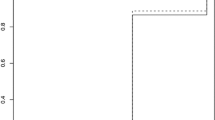Abstract
The portfolio selection problem with one safe andn risky assets is analyzed via a new decision theoretic criterion based on the Recourse Certainty Equivalent (RCE). Fundamental results in portfolio theory, previously studied under the Expected Utility criterion (EU), such as separation theorems, comparative static analysis, and threshold values for inclusion or exclusion of risky assets in the optimal portfolio, are obtained here. In contrast to the EU model, our results for the RCE maximizing investor do not impose restrictions on either the utility function or the underlying probability laws. We also derive a dual portfolio selection problem and provide it with a concrete economic interpretation.
Similar content being viewed by others
References
K.J. Arrow,Essays in the Theory of Risk-Bearing (North-Holland, American Elsevier, Amsterdam and New York, 1974).
G. Bamberg and K. Spremann, Implications of constant risk aversion, Z. Oper. Res. 25 (1981) 205–224.
A. Ben-Tal and A. Ben-Israel, A recourse certainty equivalent for decisions under uncertainty, this volume.
A. Ben-Tal and M. Teboulle, Expected utility, penalty functions and duality in stochastic nonlinear programming, Manag. Sci. 32 (1986) 1445–1466.
D. Cass and J.E. Stiglitz. The structure of investor preferences and asset returns, and separability in portfolio allocation: a contribution to the pure theory of mutual funds, J. Econ. Theory 2 (1970) 122–160.
A. Charnes and W.W. Cooper, Chance-constrained programming, Manag. Sci. 5 (1959) 73–79.
A. Charnes and S. Thore, Planning for liquidity in financial institutions: the chance-constrained method. J. Finance 21 (1966) 649–674.
P.C. Fishburn and R.B. Porter, Optimal portfolio with one safe and one risky asset: effect of changes in rate of return and risk, Manag. Sci. 22 (1976) 1064–1073.
J. Hadar and W. Russell, Rules for ordering uncertain prospects,Amer. Econ. Rev. 59 (1969) 25–34.
H.M. Markovitz,Portfolio Selection; Efficiency Diversification of Investment (Wiley, New York, 1959).
P.L. McEntire, Portfolio theory for independent assets, Manag. Sci. 30 (1984) 952–963.
J.W. Pratt, Risk aversion in the small and in the large, Econometrica 32 (1964) 122–136.
R.T. Rockafellar,Convex Analysis (Princeton University Press, Princeton, NJ, 1970).
S.A. Ross, Mutual fund separation in financial theory — the separating distributions, J. Econ. Theory 17 (1978) 254–286.
M. Rotchild and J.E. Stiglitz, Increasing risk: I. A definition, J. Econ. Theory 2 (1970) 225–243.
P.A. Samuelson, General proof that diversification pays, J. Finan. Quanti. Anal. 2 (1967) 1–13.
A. Sandmo, Capital risk, consumption, and portfolio choice, Econometrica 37 (1969) 586–599.
W.F. Sharpe,Portfolio Theory and Capital Markets (McGraw-Hill, New York, 1970).
J. Tobin, Liquidity preference as behavior towards risk, Rev. Econ. Studies 25 (1958) 65–85.
M.E. Yaari, The dual theory of choice under risk, Econometrica 55 (1987) 95–115.
Author information
Authors and Affiliations
Additional information
Research partly supported by ONR Contracts N0014-81-C-0236 and N00014-82-K-0295, and NSF Grant SES-8408134 with the Center for Cybernetic Studies, The University of Texas at Austin.
Partly supported by NSF Grant DDM-8896112.
Partly supported by AFOSR Grant 0218-88 and NSF Grant ECS-8802239 at the University of Maryland, Baltimore Campus.
Rights and permissions
About this article
Cite this article
Ben-Tal, A., Teboulle, M. Portfolio theory for the recourse certainty equivalent maximizing investor. Ann Oper Res 31, 479–499 (1991). https://doi.org/10.1007/BF02204865
Issue Date:
DOI: https://doi.org/10.1007/BF02204865




